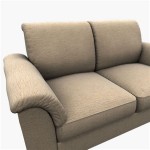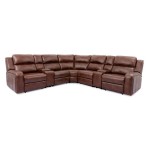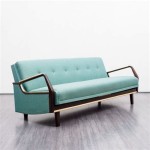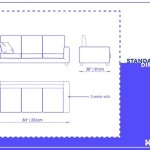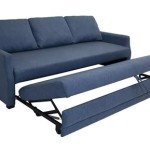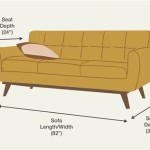Can You Change a Leather Sofa to Fabric? A Comprehensive Guide
The decision to change the upholstery of a sofa, specifically transforming a leather-covered piece into one adorned with fabric, is a significant undertaking. This endeavor involves a range of considerations, from the feasibility of the project to the practical implications of cost and aesthetic outcomes. Before embarking on this transformation, a thorough assessment is crucial to ensure alignment with both expectations and budget.
Upholstery, at its core, is the art of applying fabric, padding, and webbing to furniture frames, providing both comfort and aesthetic appeal. Changing a sofa's upholstery involves removing the existing material, making any necessary repairs to the frame and padding, and then meticulously applying the new material. This process demands precision, skill, and a comprehensive understanding of furniture construction.
The allure of changing a leather sofa to fabric stems from various motivations. Perhaps the existing leather is worn, damaged, or simply no longer aligns with evolving interior design preferences. Fabric offers a diverse palette of colors, textures, and patterns, enabling a homeowner to customize their furniture to perfectly complement their living space. Furthermore, fabric can sometimes offer a more comfortable seating experience, particularly in climates where leather can feel either too cold or too hot.
Key Point 1: Feasibility Assessment
The first crucial step is to assess the feasibility of the transformation. This involves a detailed examination of the sofa's frame. Is the frame structurally sound? Are there any signs of damage, such as cracks, warping, or loose joints? A weak or damaged frame will compromise the integrity of the new upholstery and may ultimately lead to a short-lived and unsatisfactory result. If the frame requires significant repairs, the overall cost of the project will increase substantially, potentially making replacement a more viable option.
The complexity of the sofa's design also plays a significant role. Sofas with intricate detailing, complex curves, or tufted sections are inherently more challenging to reupholster. These designs require more fabric, specialized tools, and a higher level of expertise. A simpler, more streamlined sofa will generally be easier and less expensive to convert from leather to fabric.
Furthermore, consider the existing padding and cushioning. Is the foam or filling still in good condition, providing adequate support and comfort? Over time, padding can become compressed, flattened, or even infested with mold or pests. Replacing the padding is often recommended during a reupholstery project to ensure optimal comfort and longevity. This adds to the overall cost but contributes significantly to the final result.
Finally, assess the type of leather currently on the sofa. Some leathers are more difficult to remove than others, and the ease of removal can impact the labor costs associated with the project. Thicker, more durable leathers may require specialized tools and techniques to remove cleanly, adding to the complexity and time required.
Key Point 2: Fabric Selection and Considerations
Choosing the right fabric is paramount to the success of the project. The fabric's durability, texture, color, and pattern will significantly influence the aesthetic appeal and longevity of the reupholstered sofa. Consider the following factors when selecting your fabric:
Durability: The fabric's durability should align with the sofa's intended use. For high-traffic areas or homes with children and pets, opt for durable, stain-resistant fabrics such as microfiber, canvas, or denim. These fabrics can withstand daily wear and tear and are relatively easy to clean. Avoid delicate fabrics like silk or linen, which are more susceptible to damage and require professional cleaning.
Texture: The fabric's texture can dramatically alter the look and feel of the sofa. Consider how the texture complements the overall design of the room and your personal preferences. Smooth textures like velvet or satin offer a luxurious feel, while textured fabrics like tweed or boucle add visual interest and depth. Keep in mind that some textures may be more prone to snagging or pilling, especially in homes with pets.
Color and Pattern: Color and pattern are crucial for achieving the desired aesthetic. Consider the existing color palette of your room and choose a fabric that complements or contrasts accordingly. Solid colors offer a clean and timeless look, while patterns can add personality and visual interest. Be mindful of the scale of the pattern; larger patterns can overwhelm a small sofa, while smaller patterns may get lost on a larger piece of furniture.
Cleanability: Consider the cleanability of the fabric, especially if the sofa is used frequently or if you have children or pets. Opt for fabrics that are stain-resistant and easy to clean with common household cleaners. Look for fabrics with a high Martindale rub count, which indicates the fabric's resistance to abrasion. This is particularly important for high-use areas like seat cushions and armrests.
Cost: Fabric prices vary widely depending on the material, quality, and brand. Set a budget for your fabric and research different options within that range. Keep in mind that purchasing high-quality fabric may be a worthwhile investment in the long run, as it will likely last longer and require less frequent replacement.
Key Point 3: The Reupholstery Process and Professionals
The reupholstery process is complex and time-consuming, requiring specialized skills and tools. While it is possible to undertake this project as a DIY endeavor, it is generally recommended to enlist the services of a professional upholsterer. A professional upholsterer has the experience, expertise, and equipment necessary to ensure a high-quality and long-lasting result.
Finding a Qualified Upholsterer: Seek recommendations from friends, family, or online reviews. Look for upholsterers with a proven track record of quality workmanship and customer satisfaction. Ask to see examples of their previous work and inquire about their experience with converting leather sofas to fabric. Obtain quotes from multiple upholsterers and compare prices, services, and timelines. Ensure that the quote includes all necessary materials, labor, and any additional costs associated with frame repairs or padding replacement.
The Reupholstery Steps: A typical reupholstery project involves the following steps:
Removal of Existing Upholstery: The upholsterer will carefully remove the existing leather upholstery, taking care to preserve the original pattern pieces. These pieces will serve as templates for cutting the new fabric.
Frame Inspection and Repair: The frame will be thoroughly inspected for any signs of damage. Necessary repairs will be made to ensure the frame is structurally sound and stable.
Padding and Cushioning Replacement: Worn or damaged padding and cushioning will be replaced with new materials. The upholsterer may also adjust the padding to improve comfort and support.
Fabric Cutting and Sewing: The new fabric will be carefully cut according to the original pattern pieces. The fabric pieces will then be sewn together to create the new upholstery cover.
Upholstery Application: The new upholstery cover will be meticulously applied to the sofa frame, ensuring a snug and wrinkle-free fit. The fabric will be secured with staples, tacks, or other fasteners.
Finishing Touches: The upholsterer will add any necessary finishing touches, such as trim, buttons, or decorative elements.
The cost of professional reupholstery can vary significantly depending on the size and complexity of the sofa, the type of fabric chosen, and the upholsterer's rates. However, investing in professional reupholstery can often be more cost-effective than purchasing a new sofa, especially if the existing frame is of high quality. Furthermore, reupholstery allows you to customize your furniture to perfectly match your personal style and preferences, creating a unique and personalized living space.

Recover Your Sofa From Leather To Fabric Stunning Transformation And A Lot Er Than New Rescot Upholstery

Change A Bonded Leather Sofa To Fabric Rescot Upholstery

Hide Your Couch S Wear And Tear With These 9 Ingenious Ideas Hometalk

Hide Your Couch S Wear And Tear With These 9 Ingenious Ideas Hometalk

Leather Sofa Repadding The Fast And Affordable Way To Give New Life Your Rescot Upholstery

4 Sure Ways To Revamp Your Favorite Reclining Sofa Beautyharmonylife

Cost To Reupholster A Couch Save By Recovering We Can Fix That

21 Genius Ways To Transform Your Old Sofa

Can Fabric Upholstery Be Dyed Or Refinished To Look Like Leather

Is It Worth To Reupholster A Sofa Seatup Llc

